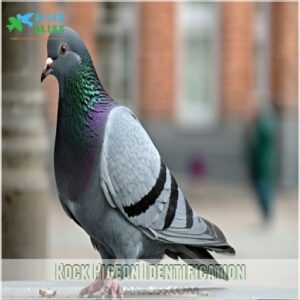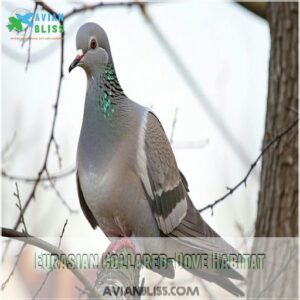This site is supported by our readers. We may earn a commission, at no cost to you, if you purchase through links.

These feathered friends frequent backyards, farmlands, and woodland edges, each with unique characteristics.
To attract them, set up platform feeders with millet and sunflower seeds, provide a shallow birdbath, and create inviting habitats with native shrubs.
They’re not just pretty faces – these doves form fascinating social structures, from intricate mating rituals to complex communication patterns that’ll make you see these birds in a whole new light. These doves are a sight to behold. Fascinating social structures.
Table Of Contents
- Key Takeaways
- Dove Species in Pennsylvania
- Attracting Doves to Your Yard
- Dove Behavior and Social Structure
- Dove Seasons and Hunting in Pennsylvania
- Dove Conservation and Management
- Frequently Asked Questions (FAQs)
- How many doves live in Pennsylvania?
- Where can I find a dove in Pennsylvania?
- Are mourning doves legal in Pennsylvania?
- How many doves are harvested a year in Pennsylvania?
- Are doves banding in Pennsylvania?
- Can you hunt doves in Pennsylvania?
- What kind of doves are in Pennsylvania?
- Is it good to have doves in your yard?
- How long is dove season in Pennsylvania?
- What month do doves lay their eggs?
- Conclusion
Key Takeaways
- You’ll find four dove species in Pennsylvania – Mourning Dove, Rock Pigeon, Eurasian Collared-Dove, and the rare White-winged Dove – each with unique characteristics and behaviors that make them fascinating backyard visitors.
- By strategically setting up platform feeders with millet and sunflower seeds, providing shallow water sources, and creating habitats with native shrubs, you can transform your yard into an inviting dove sanctuary.
- Dove hunting in Pennsylvania is regulated with specific seasons and bag limits, typically running from early September to late October, requiring proper licensing and adherence to state game regulations.
- Conservation efforts are crucial for protecting dove populations, with citizen science playing a key role in tracking migration patterns, understanding population dynamics, and supporting these beautiful birds’ survival in the state.
Dove Species in Pennsylvania
You’ll find four fascinating dove species in Pennsylvania, each with its own unique traits and habits.
From the familiar Mourning Dove’s soothing coos to the rare sightings of a White-winged Dove, these birds add charm to backyards and skies alike.
Mourning Dove Characteristics
The Mourning Dove, or Zenaida macroura, graces Pennsylvania with its pinkish-gray underside, darker gray back, and black wing spots.
Listen for their soothing cooing, a backyard soundtrack.
- Dove plumage: Graceful gray hues.
- Nest building: Minimalist stick platforms.
- Flight patterns: Straight, swift.
- Diet variations: Seeds dominate.
- Juvenile development: Nestlings stay about 15 days.
Rock Pigeon Identification
Spotting a Rock Pigeon is like recognizing an old friend in a crowd—they’re everywhere but often overlooked. Look for a plump body, gray back, and blue-gray head with two black wing bars. Their pigeon plumage variations include shades of gray or rusty tones. Young pigeons (or “squabs”) sport duller feathers.
| Feature | Description | Similar Look-Alikes |
|---|---|---|
| Size | Medium, stubby | Eurasian Collared-Dove |
| Distinctive Call | Low, throaty cooing | Mourning Dove |
| Wing Color Patterns | Two black wing bars | None |
Perfectly adapted to urban life, these resourceful birds feed on scraps and grains.
Eurasian Collared-Dove Habitat
Eurasian Collared-Doves are masters of urban adaptation, thriving in Pennsylvania’s diverse dove habitats. They prefer open spaces dotted with human structures and favor elevated nesting sites like tall trees or power lines. Their expanding habitat range keeps bird enthusiasts intrigued.
Want to attract them to your yard? Consider using specialized Eurasian dove attractants dove attractant products.
To effectively attract them to your yard, follow these steps:
- Scatter seeds—millet’s a favorite.
- Offer flat-platform feeders.
- Maintain quiet spaces; they love peace.
White-winged Dove Distribution
The White-winged dove isn’t a common sight in Pennsylvania, but its range expansion has brought occasional visits. Normally thriving in warmer southern regions, these adventurous doves are slowly pushing north.
The White-winged dove also readily visits urban bird feeders to feed on grains and seeds, making them adaptable to various environments.
Below is a quick table summarizing their traits:
| Feature | Details | Fun Fact |
|---|---|---|
| Range Expansion | Northward into Pennsylvania | Uncommon visitor |
| Habitat Preferences | Deserts, urban areas | Adapts to city life |
| Threats Faced | Predators, habitat loss | Loves fruiting plants |
| Conservation Status | Stable | Traveling and adapting species |
Attracting Doves to Your Yard
Want to transform your backyard into a dove’s paradise?
By strategically setting up the right food, water, and habitat, you’ll soon have these gentle birds cooing and fluttering around your outdoor space.
Bird Feeder Preferences
Want to roll out the red carpet for doves? Here’s your game plan:
- Choose platform or ground feeders that showcase their favorite seeds
- Scout peaceful, open locations with clear sightlines
Seed Types for Doves
Dove seed preferences can transform your backyard into a feathered feast! Different seeds attract various dove species in Pennsylvania.
Here’s your ultimate dove seed mix guide:
- Millet: Dove magnet with high nutritional value
- Sunflower Seeds: Energy-packed and irresistible
- Cracked Corn: Budget-friendly bird buffet
- Nyjer Seeds: Tiny powerhouses of dove delight
Experiment with seed mixes to discover what local Mourning doves and Rock pigeons love most in your bird feeders.
Water Sources for Doves
Keep doves coming back by offering irresistible water stations. A shallow birdbath with a gentle dripper creates a five-star hydration spot for Pennsylvania’s feathered friends.
Clean water matters most – replace daily and scrub weekly.
Position near feeding areas and away from predator hiding spots.
Considering moving water features can help prevent mosquito breeding.
Safe, accessible drinking spaces that feel like their personal oasis are especially appreciated by doves, offering them a five-star hydration spot.
Dove-Friendly Plants
A handful of strategic native plants can transform your Pennsylvania yard into a dove’s paradise.
Sunflowers, millet, and native fruit-bearing shrubs like blackberries create irresistible dove habitats.
Scatter seed-bearing plants across open spaces, mimicking the scattered woodland edges these birds love, which coincidentally mirror their preferred open woodland edges.
Your thoughtful dove plant selection will soon invite melodious cooing and gentle wing beats.
Dove Behavior and Social Structure
If you’ve ever wondered how doves live and interact, you’re in for a fascinating journey into their world of social dynamics.
You’ll discover that these birds aren’t just passive inhabitants of our landscapes, but complex creatures with intricate communication, mating rituals, and group behaviors that will surprise and delight you.
Mourning Dove Social Behavior
Often, Mourning Doves create peaceful social scenes in Pennsylvania’s landscapes.
These birds form gentle partnerships, collaborating on nest building and chick-rearing.
Pairs engage in tender courtship rituals, their soft "coo-ah" calls echoing through backyards. Watch them gracefully navigate their social world, balancing territoriality with harmonious group interactions that showcase their intricate dove behavior. dove behavior.
Rock Pigeon Flocking Habits
Rock pigeons transform city landscapes into dynamic social networks, revealing intricate flock behaviors.
Their survival strategies unfold through collective intelligence:
- Massive gatherings protect against predators
- Complex hierarchies determine feeding zones
- Synchronized movements confuse potential threats
- Group communication maximizes resource discovery
Their social structures showcase remarkable intelligence and adaptability, exemplifying cooperative breeding habits (cooperative breeding habits).
These urban birds navigate concrete jungles with remarkable adaptability, turning seemingly chaotic environments into sophisticated social networks.
Dove Communication and Vocalizations
When pigeons huddle in flocks, Mourning Doves prefer intimate chats through their haunting "coo-ah, coo, coo, coo" calls.
Their dove sounds paint a rich language of survival across Pennsylvania’s landscapes.
These vocal cues reveal complex communication methods – from mating calls to distress signals that whisper secrets of bird survival.
Dove Mating and Breeding Habits
Their cooing conversations lead to love! Mourning doves perform intricate mating rituals in Pennsylvania, with males showcasing spectacular nuptial flights to win a mate’s heart.
Females select nest sites carefully, laying two pristine eggs.
Notably, Mourning doves often choose man-made nesting sites for their nests, which can be quite flimsy.
Both parents share incubation duties, nurturing their future generations with remarkable dedication and teamwork.
Dove Seasons and Hunting in Pennsylvania
If you’re a hunter looking to bag some doves in Pennsylvania, you’ll want to know the ins and outs of the state’s hunting regulations.
Understanding season dates, bag limits, and hunting strategies can turn your dove hunting experience from hit-or-miss to consistently successful.
Dove Hunting Regulations
After mastering dove behavior, hunters must navigate Pennsylvania’s hunting regulations.
Familiarizing yourself with bag limits and hunting seasons, similar to those in Virginia where the season typically runs from September 1st to October 31st, is essential for a successful and respectful hunt.
Grab your hunting license and familiarize yourself with legal hunting methods.
Your ticket to the field requires more than just gear—it demands respect for local laws, the environment, and wildlife.
Safety, ethics, and proper documentation are your compass in this outdoor adventure.
Dove Season Dates
When dove hunting season kicks off in Pennsylvania, passionate hunters mark their calendars with anticipation. The state’s precise dove season dates promise adventure and opportunity for those ready to embrace the challenge.
- Listen for the soft wing beats at dawn
- Feel the crisp autumn air against your skin
- Watch the horizon for graceful dove flights
- Breathe in the excitement of the hunt
Bag Limits and Possession Limits
Ready to bag some doves in Pennsylvania?
Know your limits: 15 doves daily and 45 in possession.
These regulations keep hunting fair and sustainable.
Stay sharp, track your count, and respect the rules. Penalties for overbagging can clip your wings faster than a falcon’s dive.
Hunting Tactics and Strategies
Bag limits set, now let’s nail your dove hunting game in Pennsylvania. Precision matters when pursuing these swift flyers.
- Scout open fields near grain crops
- Master camouflage techniques
- Learn decoy placement strategies
- Practice smooth mounting and shooting
- Study dove flight patterns
Patience and practice separate good hunters from great ones.
Dove Conservation and Management
If you’re passionate about preserving Pennsylvania’s dove populations, you’ll want to understand the critical role habitat management and conservation play in their survival.
By learning about population trends, predator control, and ongoing research efforts, you can become an active participant in protecting these fascinating birds.
Mourning Dove Population Trends
Pennsylvania’s Mourning Dove populations have weathered significant challenges. Habitat loss and climate change threaten these resilient birds, but conservation efforts provide hope. Our feathered friends face predation risks and disease, yet their adaptive nature helps them persist.
Research on the local Dove population trends is essential to understanding their behavior and needs.
By understanding their population dynamics, we can support their survival and help these iconic Pennsylvania doves continue to thrive in our skies for generations to come.
| Factor | Impact | Mitigation Efforts |
|---|---|---|
| Habitat Loss | High | Habitat Restoration |
| Climate Change | Moderate | Adaptive Management |
| Hunting Impact | Low | Regulation |
| Nest Predation | Significant | Nest Protection |
Habitat Management for Doves
Want to transform your backyard into a dove sanctuary? Master dove habitat management with these strategic steps: By including native shrubs and trees in your landscape design, you can help protect dove habitats through sustainable farming practices.
Thoughtful landscape design is essential for creating a welcoming environment for doves. Here are some key steps to follow:
- Design shelterbelts for protection
- Create dove-friendly foraging areas
- Install strategically placed nest boxes
- Provide consistent water sources
- Minimize potential predator access
By understanding dove habitat needs, you’ll create a welcoming environment that supports their survival and thrives with natural beauty. Thoughtful landscape design invites these graceful birds to call your Pennsylvania property home.
Predator Control and Dove Conservation
Hawks and cats pose significant threats to dove populations in Pennsylvania.
Implementing strategic conservation measures helps protect these vulnerable birds.
Focus on habitat protection, reducing predator access, and educating communities about dove conservation.
Your actions can create safe havens, ensuring dove populations remain resilient against environmental challenges.
Research and Monitoring Efforts
Protecting Pennsylvania’s dove populations requires more than wishful thinking.
Citizen science transforms bird enthusiasts into conservation heroes through strategic research and monitoring.
Check out these ways you can help track our feathered friends:
- Participate in local banding programs
- Report dove sightings through online platforms
- Join regional population studies
- Contribute to range mapping initiatives
Your observations can make a real difference in dove conservation!
Frequently Asked Questions (FAQs)
How many doves live in Pennsylvania?
Wings whisper freedom as four dove species soar across Pennsylvania’s skies.
Mourning Doves, Rock Pigeons, Eurasian Collared-Doves, and White-winged Doves dance through urban landscapes and rural expanses,
each telling a unique ecological story.
Where can I find a dove in Pennsylvania?
You’ll spot doves in Pennsylvania’s open woodlands, suburban areas, and near farms.
Check bird feeders, parks, and cities—they’re everywhere!
Listen for their distinctive "coo-ah" call and watch for gray-brown birds with black wing spots.
Are mourning doves legal in Pennsylvania?
Just when hunting season rolls around, you’ll find mourning doves are legal game in Pennsylvania.
The Game Commission allows hunting during specific seasons, so check regulations and obtain the proper licenses before pursuing these feathered targets.
How many doves are harvested a year in Pennsylvania?
Hunters harvest thousands of doves annually in Pennsylvania. Exact numbers fluctuate, but mortality rates suggest 10-15% of the local dove population is taken during hunting seasons.
Are doves banding in Pennsylvania?
Wildlife biologists do track dove populations in Pennsylvania through banding programs.
These programs help understand migration patterns, survival rates, and population dynamics.
You’ll contribute to conservation efforts by reporting banded birds you encounter.
Can you hunt doves in Pennsylvania?
You’ll be dove hunting heaven in Pennsylvania!
Dove hunting in Pennsylvania requires following state game regulations. These regulations include specific seasons.
You’ll need a hunting license and must follow bag limits. Check the current wildlife guidelines before heading out.
What kind of doves are in Pennsylvania?
In Pennsylvania, you’ll spot four dove species dancing through urban and rural landscapes: the Mourning Dove, Rock Pigeon, Eurasian Collared-Dove, and the occasional White-winged Dove.
Each brings its unique charm to the state’s vibrant ecosystem.
Is it good to have doves in your yard?
Doves can be delightful yard guests, offering peaceful sounds and natural pest control. They’ll attract other wildlife and help maintain a balanced ecosystem without causing significant damage to your landscape.
How long is dove season in Pennsylvania?
Hold onto your hunting gear!
Pennsylvania’s dove season typically runs from early September to late October, spanning roughly 45-60 days.
You’ll want to check the Pennsylvania Game Commission’s current regulations for precise dates and limits.
What month do doves lay their eggs?
You’ll find most doves laying eggs from late spring through summer, typically between May and August.
They’re prolific breeders, often producing 3-6 broods per season, with peak egg-laying happening in warmer months.
Conclusion
Whether you’re a backyard birder or a curious nature lover, Pennsylvania’s doves are more than just pretty wings.
By understanding their unique behaviors and creating welcoming environments, you’ll transform your outdoor space into a dove sanctuary.
From platform feeders to native shrubs, attracting doves in Pennsylvania is an rewarding journey that connects you with these fascinating feathered residents.
Your backyard can become a thriving habitat that celebrates the beauty and diversity of dove life. attracting doves in Pennsylvania.
- https://www.allaboutbirds.org/guide/Mourning_Dove
- http://www.pabirdatlas.psu.edu/facts
- https://www.youtube.com/c/BadgerlandBirding
- https://birdwatchinghq.com/doves-that-live-in-pennsylvania/
- https://globalbirdinginitiative.org/bird-identification/species-by-location/pennsylvania-us/doves-in-pennsylvania/














